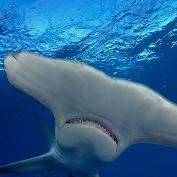Side swim style saves shark energy

Hammerhead sharks swim on their sides up to 90 per cent of the time to save energy, a Murdoch University researcher has found.
Dr Adrian Gleiss from the Centre for Fish and Fisheries Research, collaborated on an international study which found the great hammerhead species spends up to 90 per cent of its time swimming at angles of between 50 and 70 degrees.
This is thanks to an exaggerated dorsal fin which generates lift and helps to reduce drag when the sharks are rolled on their sides.
Most sharks use their dorsal fins on their backs like a rudder on a boat, to facilitate quick turns. Their large pectoral fins on their sides are used like aircraft wings to keep them from sinking. It was thought this was how all sharks functioned until this study, which was led by Dr Nicholas Payne from the University of Roehampton, London.
Dr Gleiss and the research team used video cameras and tagging to measure roll angles in hammerhead sharks in Belize, Australia and The Bahamas.
"The co-lead author on our paper, Associate Professor Gil Iosilevskii, developed hydrodynamic modeling to show this swimming method reduces energy use by around 10 per cent, compared with traditional upright swimming," said Dr Gleiss.
"Gil also conducted a series of experiments in a wind tunnel using a scale model of a hammerhead to find that minimal drag could be achieved at roll angles between 50 and 70 degrees, which closely matched the range of roll angles at which our tagged sharks swam in the wild."
Dr Gleiss said understanding how animals reduce the effects of drag on their mobility could help mechanical engineers striving to find biometric solutions for man made designs.
More information: Nicholas L. Payne et al. Great hammerhead sharks swim on their side to reduce transport costs, Nature Communications (2016).
Journal information: Nature Communications
Provided by Murdoch University



















